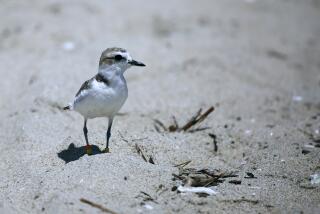Take Care on Beach to Avoid Tiny Nests
- Share via
The snowy plovers are the smallest of the plover family. They are about the size of a chicken chick and go unnoticed by most people. Yet they are common on Ormond Beach, making that beach a special place.
Because of their size, coloration and the way the birds move, it’s not uncommon to see people and dogs pass within 20 feet of these birds and never know they are there. The snowy plover, when threatened by an intruder, takes flight only as a last resort and is more likely to just blend into the background when people are passing through its territory.
There are now nests at the beach. The nests, like the birds, are difficult to spot and consist of a shallow depression lined with small pebbles and will have two to three small eggs marked to blend with the background. Snowy plover nesting sites can be located 50 feet to 200 yards from the shoreline. Judging by their current behavior and numbers, there can be as many as 50 snowy plover nesting sites along the full length of Ormond Beach.
There are no signs posted or other easily seen indications that birds are nesting on Ormond Beach. People who walk, jog or fish along the beach normally travel in the hard-pack sand of the intertidal zone and are of little threat to nesting birds. On the other hand, unleashed dogs, ATVs and four-wheel drives tend to travel through the center of the nesting areas. From late March through the end of summer there will be several types of birds trying to raise families on Ormond Beach. Eggs and young birds are easy prey for unleashed dogs and mechanized stupidity.
Please, if you travel along Ormond Beach, be aware, show a little consideration. If you watch where you step, hopefully the birds will survive our continued presence on the beach.
DALE LORENZANA
Port Hueneme






